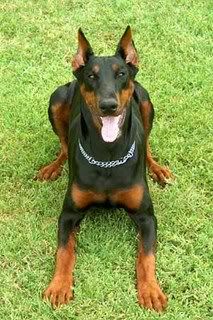|
But even playing, Wandor, a Belgian Malinois, can take down a grown man in seconds, running at 30 miles per hour and exerting 1,400 pounds per square inch of bite pressure.
“It was really cool,” said Owens, a native of Corpus Christi, Texas. “It was surprising how the dog looks so lean, but one twist, and he took me down. They’re a great asset for enforcement and detection.”
Corey, a native of Newport News, Va., has been working with dogs for three years with the 529th Military Police Company, based out of Heidelberg, Germany.
“I enjoy it,” Corey said of the March 19 practice session, which was attended by several 210th BSB soldiers. “It’s never not exciting to watch a dog take someone down.”
The 2nd BCT, based here, has several attached handlers with dogs that accompany brigade missions every day.
Army Sgt. 1st Class Michael Hart, a native of Syracuse, N.Y., and the BCT’s provost marshal, explained that most of the dogs that work with the brigade are trained to seek explosives. But they are also adept at “combat tracking.” While a human usually requires hearing two shots to pinpoint the direction of origin, dogs can point to the origin after only one shot, a skill that is critical when a sniper is shooting. Once the dog finds the shooter’s hiding place, he can track the person and even pick him out of a lineup.
There are also patrol narcotics dogs, used during health-and-welfare inspections of troops, and dogs trained to seek bodies, Hart said.
The dogs are well-trained and well-kept, Hart explained. “They have veterinary coverage twenty-four seven,” he said. “And there’s medical evacuation coverage, as well, just like there is for humans. They’re out there risking their lives too; it’s only fair.”
The handlers know basic first aid and life-support skills for the dogs, and a veterinarian is at the helipad waiting if a dog comes in injured.
So far, Hart said, the handlers haven’t needed to medically evacuate a dog. One was killed in the line of duty while searching a house; an air-conditioning unit he jumped onto had an exposed high-powered wire on it. Other than that, he explained, they have had only minor injuries, such as cut paws.
And while the handlers haven’t “let slip the dogs of war” -- as in Mark Antony’s famous speech in William Shakespeare’s “Julius Caesar” --, the animals have provided very tangible benefits for the brigade, sniffing out explosives and weaponry.
“They’re a force multiplier,” Corey said. “They can do the searching of five or six soldiers and do with their nose what a soldier has to do by prodding and digging. They make the job easier. Also, they’re a visual deterrent; the local nationals are scared of them, so they’re more cooperative.”
Corey said that Wandor has found several weapons while helping on cordon-and-search missions. “He finds weapons in houses even before the homeowners turn them over to us,” Corey said.
Instead of having to move everything in a house, he just sniffs around, and when he finds something, he sits. Then we just have to move one thing to get to the weapons.”
Navy Petty Officer 2nd Class Shannon Bragg, a native of Denver, Colo., who is assigned to a San Diego-based deployable canine unit, is also attached to the 2nd BCT.
While Bragg has been working with dogs for several years, the one assigned to him now -- “Don,” a German shepherd -- is fresh from school at Lackland Air Force Base, near San Antonio.
“He’s a ‘green’ dog,” Bragg explained. “His detection skills are much better than his aggression. He’s got a great nose on him. But he’s young, only 3, and he’s still in the puppy stage.”
Don showed his prowess at finding pieces of detonation cord hidden in the 210th BSB’s supply yard, hunkering down as he caught a whiff of explosive and then sitting as soon as he found the source.
All of the hard training works, Corey explained, because the dogs think of the job as a game.
“A dog is like a 5-year-old child,” he said. “To get a kid to do something, you make it fun.”
The object of the game for Wandor -- as it is for almost every other military working dog -- is a beehive-shaped rubber toy called a “Kong.” If he finds explosives, he gets to play. Corey explained that the dogs are trained to understand that finding the object of their search might take awhile, but if a mission is fruitless for too long, he’s prepared with a piece of detonation cord.
“I’ll hand it to someone else and ask them to hide it for me,” Corey said. Wandor can then find the cord and win some quality time playing with his Kong before moving on and continuing the quest.
“I always carry training aids to refresh his interest,” Corey said.
Athough it may be like a game for the dog, the perspective is different on the other side of those sharp teeth.
After being bitten through the padded bite suit, Army Chief Warrant Officer Julio Hall, a native of Grafton, N.H., and a supply systems technician with the 210th BSB, said he had more respect for the dogs’ power and for the capabilities they provide against terrorists.
“The dog took me down right away,” he said. “The dog itself is pretty intimidating. If I was an insurgent, I’d be petrified.”
(Army Spc. Chris McCann is assigned to the 2nd Brigade Combat Team of the 10th Mountain Division.)



